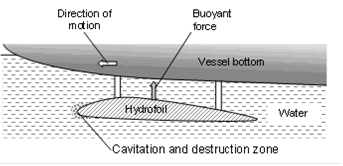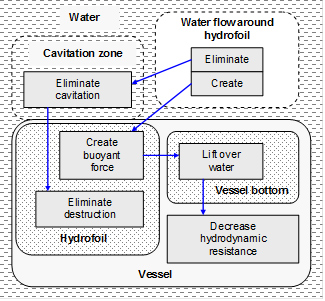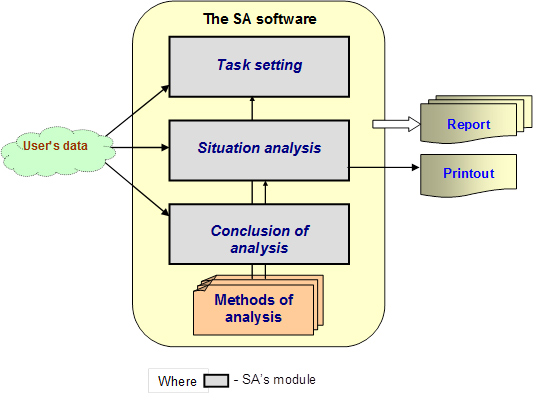Aim
This project is aimed at developing methods and an object graphical editor to build cause-and-effect models of different situations. Currently, there exist quite a number of programs which realize various cause-and-effect analysis methods (FMEA – analysis). These programs are mostly intended to reveal causes and effects of failures that occur in devices. There aren’t any programs on the market, which could analyze goal and problem situations.
The SA software employs the unified ternary language to describe situations, certain subject-oriented methods, and graphics to demonstrate results of analyses.
SA project history
The below diagram illustrates the SA project development stages.

| Combinatorial method | A formal method to synthesize the operating principle of a technical system by using the effects base (see Search for Operating Principles of Technical Systems). | |
| SA’s first prototype on the basis of reverse combinatorial method |
Advantages:
|
Disadvantages:
|
| SA’s second prototype on the basis of ternary ontology |
Advantages:
|
Disadvantages:
|
| SA 1.01 on the basis of phenomena ontology (limited version of ternary ontology) |
Advantages:
|
Disadvantages:
|
The SA project started from the combinatorial method. This method was developed to completely automate synthesis of noncontradictory chains of different effects. The inversion of the combinatorial method allowed the cause-and-effect analysis by using the effects base in automatic mode (with no human participation). SA’s first prototype was made on the basis of the reverse combinatorial method. The user described a phenomenon with SA’s terms dictionary. Then SA found a few explanations for causes and possible effects of the phenomenon. SA’s first prototype was not commercialized because it was impossible to promptly develop a comprehensive effects base.
In 2002 году Method Company completed the development of ternary ontology. In 2005 Method finished the work on context-dependent and context-independent problems (see TRIZ-fest 2007 materials). The above investigations made it possible to define the application area for SA and its interface in a new way. In 2006 Method developed SA’s second prototype – an object graphical editor based on the ternary language. In the editor, for each category of the ternary language there is a graphical symbol (20 graphical primitives in all). With the editor, the user can build models of situations from different subject areas. A few variants of graphical primitives as well as rules of their location in the editor have been developed. Below is an example of a situation model build by means of the editor.
Description of problem situation

A hydrofoil is placed on the bottom of a vessel. As the vessel moves, a buoyant force acts on the hydrofoil, lifting a part of the vessel bottom over the water surface. This decreases the hydrodynamic resistance of the vessel and increases its speed, with the engine power being the same.
When the vessel moves, a cavitation zone arises near the surface of the hydrofoil. As a result, the surface layer of the hydrofoil, which is adjacent to the zone, gets destroyed.
Target model of problem situation

Models built with SA’s second prototype are more vivid and easy to “interpret”. However, drawing such a model is time-consuming due to ever increasing number of its elements. Thus, to keep the model vivid and position newly arisen elements, already drawn elements should be constantly relocated. For this reason, SA 1.01 demonstrates a model of a situation as an oriented graph. Such graphs are easy to be drawn though less vivid. SA 1.01 has an editor which employs only three primitives: a knot, a connection, and a note.
SA’s market position
With SA, you can:
- build a cause-and-effect model of a phenomenon
- build a target model with respect to a set (initial) goal
- build a parametric model of a system
- find ways to reach an initial goal or resolve a problem situation
A cause-and-effect model makes it possible to reveal the most likely causes and most important effects of a phenomenon to be observed.
A target model specifies substitute goals which, when reached, allow the user to achieve an initial goal by indirect means.
A parametric model of a system demonstrates the dependence of external properties of the system, for example, its technical indices, on the parameters of its elements.
In a number of cases a target model makes it possible to find ways to achieve an initial goal or to eliminate a problem situation. It is due to the fact that the ways to reach a few substitute goals are self-evident. Thus, such substitute goals are the ways to achieve an initial goal or the ways to resolve problem situations.
SA makes an analytical report by using input data and a built situation model. The report describes a situation, its model due to the analysis of the situation, and conclusions made from the analysis.
The above SA’s functions define corporate and individual users of the software.
Corporate Users
| User | Purchase motives |
| R&D department* |
|
| Higher education engineering institution |
|
* For industrial divisions having independent expenditure budgets.
Individual Users
| User | Purchase motives |
| engineer-researcher designer inventor teacher college student |
|
How SA works
Work with SA consists of 3 stages:
- setting a task
- analysis of a situation
- making conclusions of the analysis
A proper SA’s module corresponds to a proper stage.
SA’s functional scheme

1 Task setting
At the first stage the user employs the Task setting module. In the module, the user specifies:
- name of a project under which a situation is supposed to be analyzed
- description of the situation
- possible ways to analyze the situation
- some common data for the analytical report title-page
The initial description of a situation includes different parts – text parts, drawings, charts, math formulae, etc.
Generally, one and the same situation can be analyzed in different ways, with each way being given a few equivalent names. Thus, working with SA the user can make a list of a few variants of goal analysis. After, one of the variants is to be chosen.
2 Situation analysis
▶ Situation simulation
The analysis of a situation comprises two stages: building a graphical model of the situation and making analysis results. To build a situation model use is made of a special object graphical editor. The results of analysis represent a part of information selected from the situation model and transferred to the summary table.
The ternary language is used to describe a model of a situation. This language operates with such notions as object, property, and relation [1 и 2].
A model of a problem situation is a directed graph the user builds by means of a special object graphical editor. In the knots of the graph the user specifies phenomena, goals, or changes in properties of objects, depending on a type of a model. The knots of the graph are connected with arrows which indicate cause-and-effect relations between the knots. More information (notes) can be given with respect to any element of a model.
With proper symbols one can define the modality of data specified in the graph knots: “desirable”, “undesirable”, as well as “desirable and undesirable”.
To demonstrate how a situation changes with time, the user can divide a model of the situation into stages. A model of a stage is an individual graph. Such models are interconnected via at least one common object.
▶ Analysis results selection
The user can choose a number of knots from a situation model built and copy the text from the knots to the “Analysis results selected” list. The name of a list head changes with a situation analysis goal.
In the list, if necessary, the results of analysis can be positioned in a desired way. For example, for a model in which causes of a phenomenon are specified, the most probable causes can be selected and positioned in the decreasing order.
3 Conclusions made from analysis
Upon completion, the user can put down, if necessary, conclusions made from the analysis of a situation.
4 Additional functions
Apart from the main operation modes SA executes a number of additional functions.
▶ Project management
All current results of SA’s operation can be stored in the projects base. A projects manager is used to manage the base. The manager lets download proper projects to SA and delete unnecessary ones from the base.
▶ Help information review
Setting a task and building a model of a situation the user can view the methods and glossary. The glossary contains terms frequently used in the methods for analyses of situations. In addition, at any moment the user can open Help (User manual).
The Help contains all data necessary for independent training to work with SA.
SA project theoretical platform
The literature below considers the fundamentals of ternary ontology.
- Ujomov A.I. Things, Features and Relationships. Moscow, Publishing House of the USSR Academy of Science, 1963.
- Ujomov A.I. System Approach and General Theory of Systems. Moscow, Mysl Publishers, 1978.
